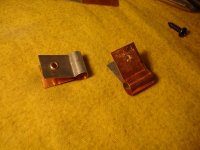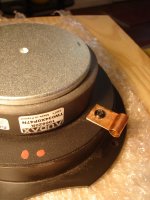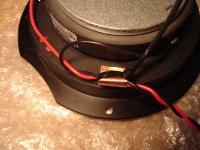So it makes more sense to use low resistance wire and an additional resistor than just using cheaper wire that comes up with the same resistance as thicker wire plus resistor?
I find good wire better than wire + resistor so no, these are not perfectly equivalent.
dave
I want what comes out of my amplifiers to be fed without issues or changes to my speakers.
Anything else is nonsense.
Anything else is nonsense.
Then move your amps to where the speakers are and use as short a wire as possible. I don't know what Dave would do under those circumstances, use fuse wire maybe?
Then move your amps to where the speakers are and use as short a wire as possible. I don't know what Dave would do under those circumstances, use fuse wire maybe?
Yes, my main system has about 8 to 10 feet of 16 gauge zip wire to each speaker.
Quote:
Originally Posted by JMFahey View Post
In any case, good speaker designers must consider their cabinets being driven from a Voltage source (your average amplifier out there) plus, say, 0.1 or 0.2 ohms (cable and terminal resistance) in series.
And should not be rendered unusable by, say, 0.5 ohm
Which I bet they do, simply being realistic and designing stuff to be actually *used* in, say, a Living Room or equivalent.
Stuff which only works in a Lab environment but has problems anywhere else does not have much future.
Is this DIYaudio or an online workshop for engineers designing audio gear for Wal Mart?
Not sure what´s your point.
Do you mean speakers should be designed to be used with superconductor cables only?
Or only viable speakers are active ones with speaker terminals soldered straight to transistor emitters?
Maybe you didn´t notice there is a difference between armchair designers, based *only* on Simulation and its World of Oz "ideal components", and REAL Designers, who must meet mutually conflicting: Specs - Cost - Deadlines - Suppliers - Personnel - Logistics - etc.
By the way, there´s a dime a dozen of the first kind and the real ones are as rare as hen´s teet.
My point is that if a person builds a system that doesn't need to interact with other systems there is no need to consider these other systems and accepted standards for interaction.
A practical example for the abstract challenged: It's perfectly ok to design and build a source with an output level of 35Vpp and build the rest of the system to work with that in your home. It doesn't make sense to do that in a commercial product that will be connected into a system built to accept a 1.7Vpp signal.
Thats all.
A practical example for the abstract challenged: It's perfectly ok to design and build a source with an output level of 35Vpp and build the rest of the system to work with that in your home. It doesn't make sense to do that in a commercial product that will be connected into a system built to accept a 1.7Vpp signal.
Thats all.
The person that often writes about it, is Jim Brown past AES committee co-chair on EMI/RFI and a Ham radio operator (who often does interference seminars and posts in interference forums).Speaker cable is a terrible antenae and the amp is a large RF load. Any RF that gets past that is usually bypassed before the input stage. Dont care if people write about it, why dont they test it. it would be very easy to test by injecting some RF into a speaker cable and measuring the input. Show me the numbers, not the BS.
It's a subject often touched on in his 50 papers and Power Points.
Audio Systems Group, Inc. Publications
As for testing, some of his AES papers are real world interference tests.
The person that often writes about it, is Jim Brown past AES committee co-chair on EMI/RFI and a Ham radio operator (who often does interference seminars and posts in interference forums).
When I did 6m ham transmission, interference with the upper end of the FM band was my specialty!
btw -- had my first visit to "Play it Again Sam" a few weeks ago.
The length of 'skinny' connecting wire inside a speaker cabinet is so short that it introduces an insignificant amount of resistance to the flow of current.
It is in the longer run between the amplifier and the speaker where the benefits of using a thicker wire to reduce resistance are obtained.
Using too thick a wire internally can cause problems in crimping or soldering the thick wire to the driver terminals as well as putting undue stress on the terminals due to the weight of the cable.
That is a real problem.
And there are cables that are extremely hard, so you have to secure them in some way so they do not break the terminal.
I found this way.
Attachments
"Play it Again Sam" is a used hi-fi equipment shop about a mile from my house. It's a step back in time. They have been open for four decades now............
btw -- had my first visit to "Play it Again Sam" a few weeks ago.
Play it Again Sam | Home
Reminds me of a shop down the street from me. Hi-Fi Fo Fum. "The goods are odd, but the odds are good"
hi fi fo fum
hi fi fo fum
this is essential but also important is the use of single wires for the pos. and neg. rail - go to post #1110 underThe best speaker wire I ever used, went direct from the amp to the speaker with little detouring, and had clean contacts.
Life is easy if you think lamp cord because no one can hear the difference with the boutique cables and if they do it's because of a problem with them, not the lamp cord.
Stop sweating what the SO'ers tell you.
https://www.diyaudio.com/community/...ake-any-difference.73632/page-56#post-7004937
P.S.: there are a lot of closed threads concerning this topic:
https://www.diyaudio.com/community/...nake-oil-or-is-there-more-to-it.363012/page-3
https://www.diyaudio.com/community/threads/can-be-there-real-difference-in-cables.355193/
https://www.diyaudio.com/community/...es-make-a-difference-any-input.15600/page-745
https://www.diyaudio.com/community/threads/speaker-cable-myths-and-facts.193100/
https://www.diyaudio.com/community/threads/speaker-wires-analysis-and-results.342645/
https://www.diyaudio.com/community/threads/ultimate-speaker-cable-design-diy.301049/
Maybe you can add this URLs in this closed threads:
https://www.diyaudio.com/community/threads/the-null-tester.347300/
https://audioxpress.com/article/you-can-diy-building-a-null-tester-device
Thank you very much - this makes finding of this very interesting test methody much easier for many users.
Just another "wire thread", one of many such boring threads on many audio websites, along with many arguments in all directions.
And with many "beliefs" tossed around from people with little to no knowledge of basic electricity, audio specifics, and contempt for good copper wiring.
And with many "beliefs" tossed around from people with little to no knowledge of basic electricity, audio specifics, and contempt for good copper wiring.
That's why I referred to the last URL's in my previous post.Just another "wire thread", one of many such boring threads on many audio websites, along with many arguments in all directions.
And with many "beliefs" tossed around from people with little to no knowledge of basic electricity, audio specifics, and contempt for good copper wiring.
For a shock of REALITY:Cut up a loudspeaker and unwind the voice coil. That wire is long and SKINNY!!
You do need "better" wire TO the speaker so that the voice coil gets most of the power. But 15 feet of lampcord, or 2 feet of hookup wire, is not a big deal compared to the speaker guts.
I wind my own voice coils.
A typical 8 ohm 38mm diameter 14mm winding length (to allow 4mm X max) woofer voice coil uses 13.5 METERS (112 turns in 2 layers) of skinny 0.22 mm diameter round copper wire (plain enameled motor quality Industrial copper, not silly fairy dust type), about #32 AWG .
Ok, now continue arguing about silly cabinet interconnection wire 😉
In case this is hard to grasp, here is a burnt voice coil so wire is easily seen:
For the whole gallery of horrors:
https://www.diyaudio.com/community/...wiring-cable-requirements.304991/post-5017191
What is it about today?
All the Looney Tunes wire people came out of the woodwork!
Many threads open today...
All the Looney Tunes wire people came out of the woodwork!
Many threads open today...
- Home
- Design & Build
- Parts
- Speaker wire


